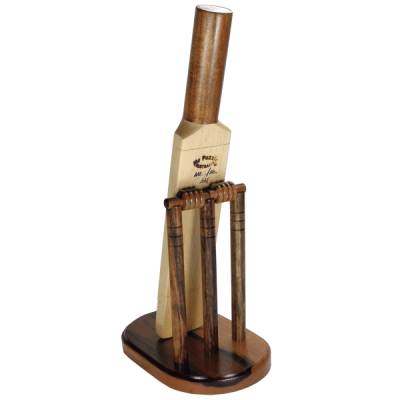L Burr designed by Juno
22 December 2012Sold out 2012 Limited Edition Set of 30. Original Price: AU$210.00 (AU$190.91 ex Australian Tax) In May 2021 one of these puzzles resold at Puzzle…


Designer: Brian Young. Three major locks and much much more. No gravity pins; no “bashing” or “tapping”. Tools to discover for all steps in the puzzle.
The name is The Opening Bat and that’s exactly what you have to do; open the cricket bat to find all you will need to play test cricket and win that holy grail.
By buying this single Limited Edition puzzle you’re getting a number of puzzles in one. It’s not just a single puzzle. This puzzle will seem to go on and on. You will be continually finding more tools and more puzzles to solve. This mammoth puzzle combines many ideas into one sequential discovery puzzle that tells a story as you solve each step of the puzzle. And there are a lot of steps including three major locks and more different puzzles, locking mechanisms and tools than Brian has ever incorporated into a single puzzle before.
Yes, there are lots of locks, but no gravity pins. And yes, there are lots of magnets but no “tapping” or “banging”; there’s tools supplied to solve each of the locks.
We have supplied you with all you need to play Test Match cricket and win back the Ashes for Australia. The cricket bat, the wickets & bails, and the oval are plain to see. But you’ll also need another set of wickets, a ball, a baggy green cap. When you find them all you’ll have everything you need to win back the holy grail of cricket – the urn that holds the ashes.
Brian has been working on ideas to incorporate in this puzzle for almost a decade; the first ideas for a cricket bat puzzle were conceived when the Sir Donald Bradman 20c coin was released in Australia in 2001 and Brian thought it would make a nice cap for the handle and the space inside the bat would give him the flexibility and room required to include so many steps in the puzzle. In that time he’s had many wild ideas and it seems he put them all in to this one puzzle with many, many other tools to discover to solve the three major locks and other puzzles included. When it came to actually making the puzzle they all seemed to flow from one section to another so Brian decided to leave them all in; even adding more along the way to make that happen. As far as sequential discovery puzzles go this one’s on steroids!
Brian has machined over 20 individual metal components which make up the locks and the tools required to operate them. There’s a lot of woodturning too, right down to the wooden urn which is an essential key to one of the locks. Since returning from IPP30 in Japan he seems to have done nothing else!
Materials: The blade of the cricket bat is made from Queensland Silver Ash. The traditional wood is willow but this wood is not stable enough to make a puzzle from. The handle is turned out of Tasmanian Blackwood and has an original Sir Donald Bradman 20c coin imbedded in the top of the handle. The Oval, and the Wickets & Bails, are made from Papua New Guinean Ebony.
Size: Bat – 350mm x 60mm x 35mm Oval – 185mm x 125mm Height of wickets – 200mm
Solution: We’ll do a proper step by step solution for this puzzle. Each step will be on a separate page so if you get stuck at one point you can see that part of the solution and move on without spoiling the whole puzzle. The solution will be available on request but only after all the puzzles are finished and hipped.
Glossary:You don’t actually have to know how to play cricket to do this puzzle but there is some strange language to understand if you’re not a fan.
Test Match cricket – A match of cricket between nations that lasts for 5 days of play. The first Test Match took place in March 1877 between Australia & England.
The Ashes – A special series of 5 Test Matches of cricket that has been played between Australia & England since 1882. The series is named after a satirical obituary published in a British newspaper in 1882 after they had lost the previous test series to Australia. A small urn reputed to contain the ashes of an item of cricket equipment was awarded as a trophy.
Oval – A large circular or oval shaped grass field on which the game is played. It is the only sports ground in the world with no fixed shape or size.
Pitch – A very flat strip in the centre of the oval covered with very short grass. One set of wickets is at each end of this strip. Runs can be made by batsman running between these wickets.
Cricket Bat – A wooden bat traditionally made from White Willow wood with a cylindrical handle and a long blade, flat on the hitting surface and shaped to a V at the back. The opening bat is the first batsman to face the bowler in an innings.
Cricket Ball – A solid hard ball made of cork and leather usually about 73mm in diameter.
Stumps – Three vertical posts which support two bails that when assembled together form the wickets. There is one set at each end of the pitch.
Bails – Two small sticks placed on top of the three stumps to form a wicket. The bails are used to determine if the wicket is broken, which in turn may mean the batsman is out.
Wickets – The term is used for one of the two sets of assembled stumps & bails that the batsman must protect and stop the bowler hitting with the ball.Baggy Green Cap – Possibly the most famous cricket cap in the world, versions of this cap have been worn by Australian Test cricketers since around the turn of the 20th century.